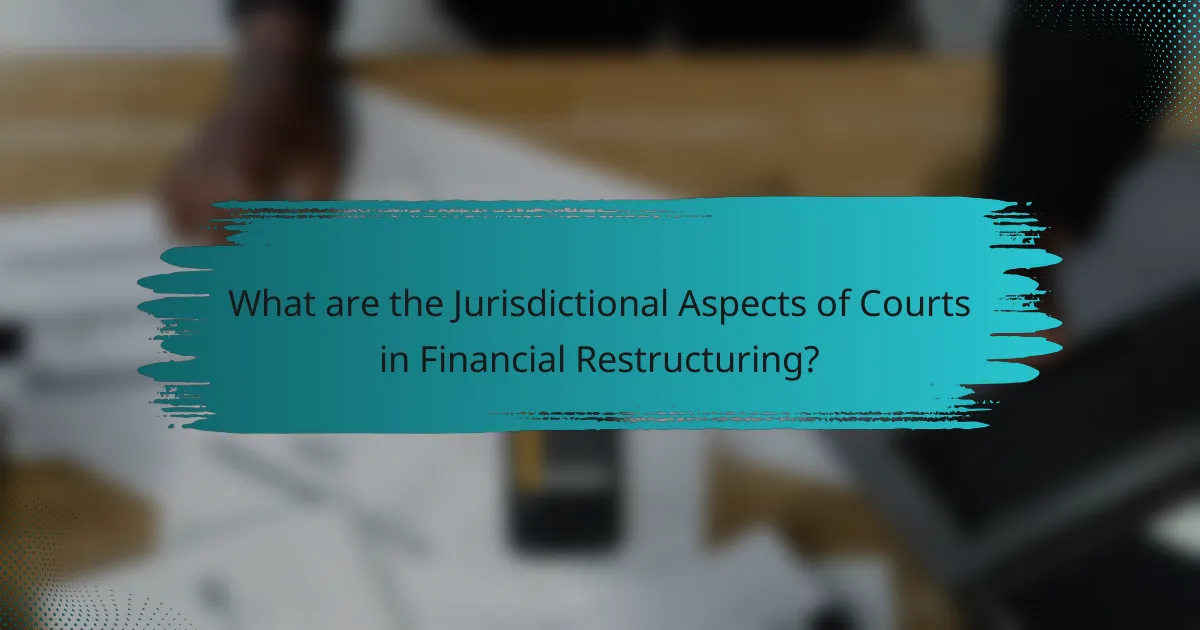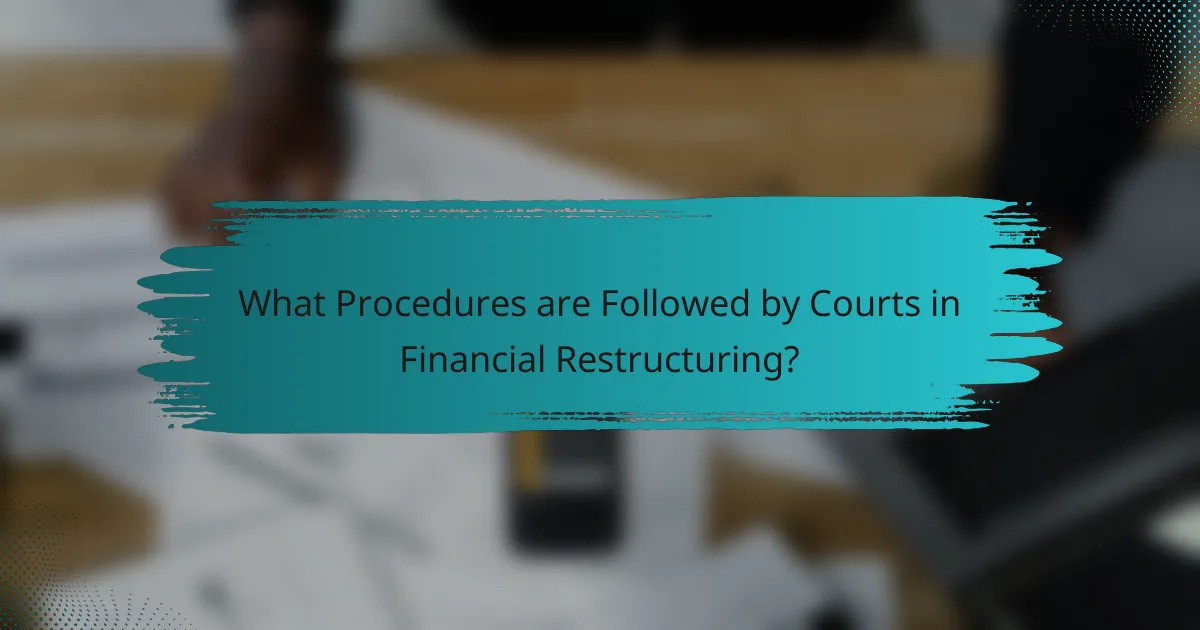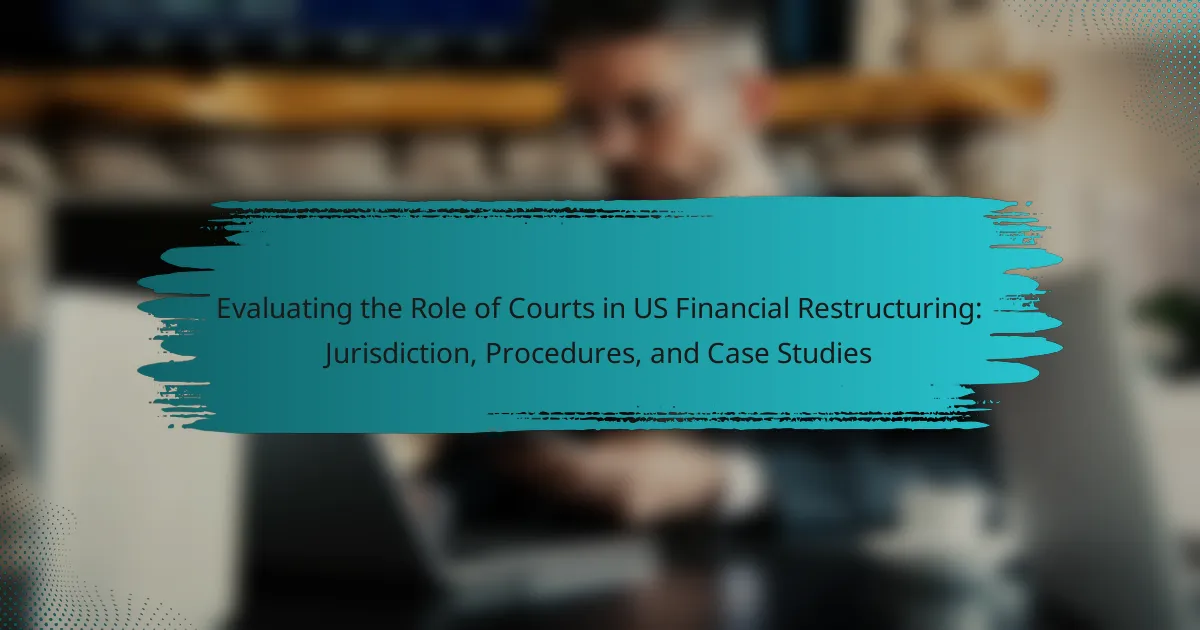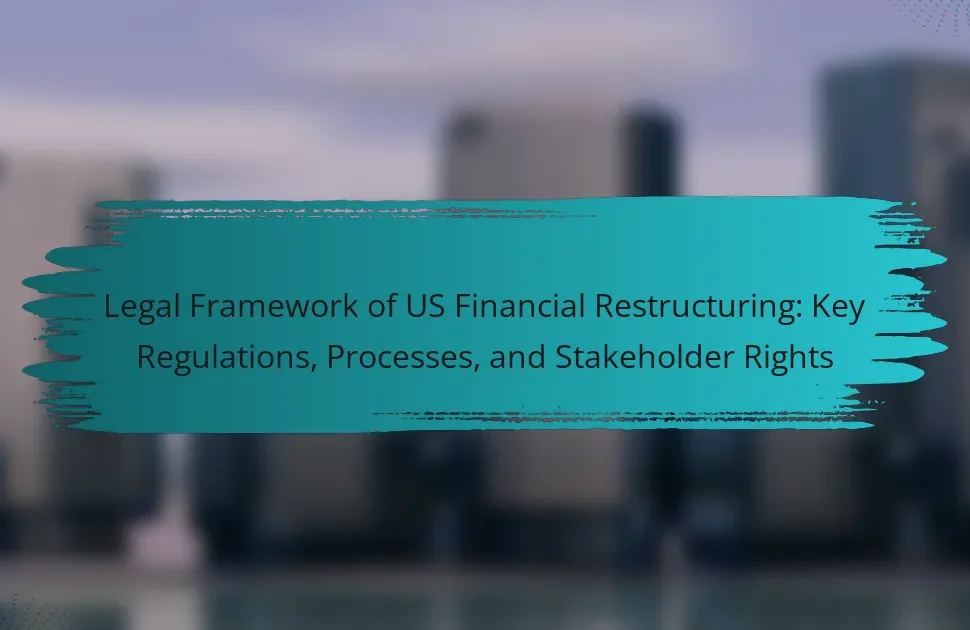Courts are the primary entities overseeing financial restructuring in the United States, specifically managing bankruptcy proceedings under the Bankruptcy Code. This article evaluates the jurisdictional authority of federal bankruptcy courts, which includes adjudicating Chapter 11 reorganizations and Chapter 7 liquidations. It outlines the procedural steps courts follow, from the initial bankruptcy petition to the approval and monitoring of reorganization plans. Additionally, it highlights the role of courts in facilitating negotiations between debtors and creditors and resolving disputes, using historical case studies such as General Motors in 2009 to illustrate their significant impact on financial recovery and asset distribution.

What is the Role of Courts in US Financial Restructuring?
Courts play a critical role in US financial restructuring. They oversee bankruptcy proceedings under the Bankruptcy Code. Their jurisdiction includes Chapter 11 reorganizations and Chapter 7 liquidations. Courts ensure compliance with legal standards during these processes. They facilitate negotiations between debtors and creditors. Courts also approve restructuring plans that meet statutory requirements. Their decisions can impact the distribution of assets. Historical cases, like General Motors in 2009, illustrate their influence on financial recovery.
How do courts influence financial restructuring processes?
Courts influence financial restructuring processes by overseeing bankruptcy proceedings and approving reorganization plans. They ensure compliance with legal standards and protect creditor rights. Courts also facilitate negotiations between debtors and creditors. This mediation can lead to more equitable outcomes. Judicial rulings can set precedents that shape future restructuring efforts. For instance, the U.S. Bankruptcy Code provides a framework that courts use to evaluate cases. Specific cases, like the General Motors bankruptcy in 2009, demonstrate the court’s role in facilitating large-scale restructurings. Overall, courts act as impartial arbiters in complex financial disputes.
What are the key functions of courts in these cases?
The key functions of courts in financial restructuring cases include adjudicating disputes, overseeing bankruptcy proceedings, and ensuring equitable treatment of creditors. Courts determine the legality of restructuring plans. They also provide a framework for negotiations among stakeholders. Courts enforce compliance with federal bankruptcy laws. They protect the interests of debtors while balancing creditor rights. Furthermore, courts facilitate the appointment of trustees to manage assets. These functions are essential for maintaining order in complex financial situations.
How do courts ensure compliance with financial laws?
Courts ensure compliance with financial laws through various mechanisms. They interpret and enforce statutes related to financial regulations. Courts also review cases involving financial disputes and violations. They impose penalties on entities that breach financial laws. Judicial oversight ensures adherence to legal standards in financial practices. Courts may mandate corrective actions to rectify non-compliance. Compliance is further ensured through monitoring and reporting requirements set by the courts. These processes help maintain the integrity of the financial system and protect stakeholders.
What types of financial restructuring cases do courts handle?
Courts handle several types of financial restructuring cases. These include bankruptcy proceedings, where entities seek relief from debts. Courts also manage Chapter 11 reorganizations, allowing businesses to restructure while continuing operations. Additionally, they oversee Chapter 7 liquidations, where assets are sold to pay creditors. Courts handle debt restructurings outside of bankruptcy, often involving negotiated agreements between creditors and debtors. Furthermore, they adjudicate cases involving distressed mergers and acquisitions. These cases can involve complex legal and financial issues requiring judicial oversight.
What distinguishes Chapter 11 from Chapter 7 bankruptcy cases?
Chapter 11 bankruptcy allows businesses to reorganize their debts while continuing operations. In contrast, Chapter 7 bankruptcy involves liquidating assets to pay creditors. Chapter 11 is primarily for corporations seeking to restructure, while Chapter 7 is often for individuals or businesses that cannot repay debts. Chapter 11 cases can lead to a repayment plan, typically lasting three to five years. Conversely, Chapter 7 results in the immediate sale of assets, with the process often completed within a few months. Additionally, Chapter 11 requires court approval for plans, while Chapter 7 does not involve a reorganization plan.
How do courts manage out-of-court restructurings?
Courts manage out-of-court restructurings by providing oversight and facilitating negotiations among stakeholders. They ensure compliance with legal standards and protect the interests of creditors and debtors. Courts may appoint mediators to assist in negotiations. They can also enforce agreements reached by parties involved. Additionally, courts may review proposed plans to ensure fairness and transparency. In some cases, judicial approval is required for certain restructuring actions. This oversight helps maintain order and prevent disputes during the restructuring process. Courts play a crucial role in balancing the rights of all parties involved.

What are the Jurisdictional Aspects of Courts in Financial Restructuring?
Jurisdictional aspects of courts in financial restructuring primarily involve the authority of courts to adjudicate bankruptcy cases. Courts determine which cases fall under their jurisdiction based on the location of the debtor and the nature of the financial issues. Federal bankruptcy courts in the United States have exclusive jurisdiction over bankruptcy cases. This jurisdiction is established under Title 11 of the United States Code. Courts also assess whether they can hear cases involving international debtors under the Chapter 15 provisions. Additionally, jurisdiction can be affected by the type of restructuring sought, such as Chapter 11 or Chapter 7. Courts may also consider related state law claims in conjunction with federal bankruptcy proceedings. The jurisdictional framework is essential for ensuring that cases are handled in the appropriate legal venue.
How is jurisdiction determined in financial restructuring cases?
Jurisdiction in financial restructuring cases is determined by the location of the debtor’s principal place of business or assets. Courts assess whether they have the authority to hear a case based on these factors. The Bankruptcy Code allows for jurisdiction in the district where the debtor resides or has a domicile. Additionally, the choice of jurisdiction may depend on the type of restructuring sought, such as Chapter 11 or Chapter 7. Courts often consider the convenience for creditors and the administration of the case. The legal framework also includes the concept of “venue,” which can influence jurisdictional decisions. Ultimately, jurisdiction is a critical aspect that impacts the proceedings and outcomes of financial restructuring cases.
What factors influence a court’s jurisdiction?
Jurisdiction of a court is influenced by several key factors. These include the geographical location of the parties involved. The type of case also plays a significant role. Courts have jurisdiction based on the subject matter of the dispute. Additionally, the amount in controversy can determine jurisdiction. Personal jurisdiction is established through the defendant’s connections to the forum state. Federal courts have jurisdiction under specific circumstances, such as diversity of citizenship. Statutory provisions can also dictate jurisdictional limits. These factors collectively shape the authority of courts to hear cases.
How do state and federal jurisdictions interact in these cases?
State and federal jurisdictions interact through a system of concurrent powers. Both levels of government can enact laws and regulations affecting financial restructuring. Federal law often sets a baseline for financial regulations, such as bankruptcy laws. States may create additional laws that complement or expand upon federal statutes. Conflicts can arise when state laws contradict federal regulations. In such cases, federal law typically prevails due to the Supremacy Clause of the Constitution. Courts often resolve these jurisdictional disputes through interpretation of the law. This interaction is crucial in ensuring a cohesive legal framework for financial restructuring.
What are the implications of jurisdiction on case outcomes?
Jurisdiction significantly affects case outcomes in the legal system. It determines which court has the authority to hear a case. Different jurisdictions have varying laws and procedural rules. These differences can influence the interpretation of legal issues. For instance, a case may be decided differently in state court compared to federal court. Jurisdiction also impacts the availability of certain legal remedies. Courts in different jurisdictions may have distinct approaches to similar cases. This variability can lead to inconsistent outcomes for similar legal matters. Thus, understanding jurisdiction is crucial for predicting case results.
How can jurisdictional issues affect creditor rights?
Jurisdictional issues can significantly affect creditor rights by determining which court has authority over a bankruptcy case. The chosen jurisdiction influences the legal framework and applicable laws governing the proceedings. Different jurisdictions may have varying rules regarding the treatment of creditors, including priority of claims and dischargeability of debts. For example, some jurisdictions may favor secured creditors over unsecured creditors, impacting their recovery potential. Additionally, jurisdictional differences can affect the enforcement of creditor rights in terms of asset seizure and lien priority. Courts in certain jurisdictions may also impose stricter requirements for creditors to assert their claims. Therefore, the jurisdictional context is crucial for creditors in understanding their rights and potential outcomes in financial restructuring cases.
What role does jurisdiction play in the speed of proceedings?
Jurisdiction significantly affects the speed of legal proceedings. Different jurisdictions have varying rules and procedures that can expedite or delay cases. For instance, some jurisdictions prioritize efficiency and have streamlined processes. Others may have more complex regulations that can prolong litigation. Additionally, the type of court involved influences timing. Federal courts often have different timelines compared to state courts. A study by the Federal Judicial Center indicates that cases in jurisdictions with fewer procedural hurdles are resolved faster. Thus, jurisdiction plays a crucial role in determining how quickly legal matters progress.

What Procedures are Followed by Courts in Financial Restructuring?
Courts follow specific procedures in financial restructuring. The process typically begins with the filing of a petition for bankruptcy or reorganization. The court then assesses the eligibility of the entity seeking restructuring under relevant laws, such as Chapter 11 of the Bankruptcy Code. A creditors’ committee may be appointed to represent the interests of unsecured creditors.
The court oversees the development of a reorganization plan, which outlines how debts will be addressed. This plan must be approved by the court and accepted by creditors. A confirmation hearing is held where the court evaluates the plan’s feasibility and compliance with legal requirements.
Once approved, the court monitors the implementation of the plan to ensure adherence. Courts also resolve disputes that arise during the restructuring process. These procedures are designed to balance the interests of debtors and creditors while facilitating a fair resolution.
What are the typical steps in a court-led financial restructuring process?
The typical steps in a court-led financial restructuring process include several key phases. First, the filing of a petition for bankruptcy initiates the process. This petition is usually filed under Chapter 11 of the Bankruptcy Code in the U.S. Next, the court appoints a trustee or allows the company to remain in possession of its assets. The company must then develop a reorganization plan, which outlines how it will address its debts. This plan must be approved by the court and creditors. After approval, the company implements the plan and begins making required payments. The final step is the discharge of debts that are not paid, allowing the company to emerge from bankruptcy. These steps are guided by legal frameworks to ensure fair treatment of creditors and stakeholders.
How do initial filings set the stage for restructuring?
Initial filings initiate the legal process for restructuring. These filings typically include petitions for bankruptcy or reorganization. They provide the court with essential information about the entity’s financial status. This information helps the court assess the viability of a restructuring plan. Additionally, initial filings establish an automatic stay on creditor actions. This stay allows the entity to reorganize without immediate pressure from creditors. Following these filings, the court can appoint a trustee or monitor the restructuring process. The filings set the legal framework that guides subsequent restructuring steps.
What role do hearings play in the restructuring process?
Hearings play a critical role in the restructuring process by facilitating communication between stakeholders. They provide a platform for creditors, debtors, and other interested parties to present their views. This process ensures transparency and allows for the examination of the proposed restructuring plans. During hearings, the court evaluates the viability of the plans based on the evidence presented. The outcomes of these hearings can significantly influence the final decisions made by the court. Additionally, hearings help in identifying any objections or concerns that need to be addressed. This interaction can lead to modifications of the restructuring proposals to better satisfy stakeholder interests. Overall, hearings are essential for ensuring an equitable restructuring process.
How do courts handle disputes during financial restructuring?
Courts handle disputes during financial restructuring through the application of bankruptcy laws and judicial discretion. They assess claims and objections from creditors and debtors. Courts may facilitate negotiations to reach settlements. If disputes escalate, courts can conduct hearings to evaluate evidence. They issue rulings based on the merits of each case. Courts also ensure compliance with legal standards and protect the rights of all parties involved. This process is governed by the U.S. Bankruptcy Code, which provides a framework for resolving financial disputes. Judicial decisions during these proceedings can set precedents for future cases in financial restructuring.
What mechanisms are in place for resolving conflicts?
The primary mechanisms for resolving conflicts in US financial restructuring include court proceedings, mediation, and arbitration. Court proceedings allow for legal adjudication under the jurisdiction of bankruptcy courts. These courts follow established procedures to handle disputes related to financial restructuring. Mediation provides a collaborative approach where a neutral third party helps facilitate negotiation between conflicting parties. Arbitration offers a binding resolution through an arbitrator, providing an alternative to court litigation. Each mechanism is designed to address specific types of conflicts efficiently. Courts, for instance, ensure adherence to legal standards and protect creditor rights. Mediation and arbitration can often lead to faster resolutions, reducing the burden on court systems.
How do courts enforce decisions made during restructuring?
Courts enforce decisions made during restructuring through legal authority and judicial oversight. They ensure compliance with restructuring plans approved in bankruptcy proceedings. Courts can issue orders to enforce specific terms of the plan. They also have the power to hold parties accountable for non-compliance. For example, courts may impose sanctions or penalties for violations. Additionally, courts facilitate the resolution of disputes arising from the restructuring process. They interpret and apply relevant laws to uphold the integrity of the restructuring. This process is essential for maintaining order and fairness in financial restructuring cases.
What are some notable case studies of court involvement in financial restructuring?
One notable case study of court involvement in financial restructuring is the General Motors (GM) bankruptcy case in 2009. The U.S. Bankruptcy Court for the Southern District of New York oversaw the restructuring process. This case involved a rapid sale of GM’s assets to a new entity, allowing for a streamlined recovery process. The court approved a plan that reduced GM’s liabilities while preserving jobs and operations.
Another significant case is the Chapter 11 filing of Lehman Brothers in 2008. This case remains the largest bankruptcy in U.S. history. The court’s involvement was critical in managing the complex asset liquidation process. The court facilitated negotiations among creditors and stakeholders to maximize asset recovery.
Additionally, the case of Pacific Gas and Electric (PG&E) in 2019 highlights court involvement in financial restructuring due to liabilities from wildfire claims. The Bankruptcy Court for the Northern District of California approved a plan that addressed these claims while ensuring the utility’s continued operation.
These case studies illustrate the essential role of courts in navigating complex financial restructurings, balancing creditor interests, and facilitating recovery.
What lessons can be learned from landmark cases?
Landmark cases provide critical lessons on legal precedents and judicial interpretation. They illustrate how courts shape financial restructuring laws. For example, the case of United States v. Whiting Pools, Inc. established the principle of “property of the estate.” This case clarified what constitutes estate property in bankruptcy. Another significant case, In re Continental Airlines, Inc., highlighted the importance of good faith in restructuring negotiations. These rulings guide future cases by establishing legal standards and expectations. They also demonstrate the balance between creditor rights and debtor protections. Understanding these lessons aids in navigating complex financial restructuring scenarios.
How do case studies illustrate the effectiveness of court procedures?
Case studies illustrate the effectiveness of court procedures by providing real-world examples of outcomes. They showcase how legal frameworks operate in practice. Specific cases demonstrate the application of laws and their impact on financial restructuring. For instance, the case of General Motors’ bankruptcy in 2009 highlighted the efficiency of expedited procedures. It resulted in a swift resolution, preserving jobs and stabilizing the company. Data shows that cases with structured court procedures often lead to higher recovery rates for creditors. Additionally, case studies reveal patterns in judicial decision-making. They help identify best practices that enhance procedural effectiveness. Overall, these examples serve as evidence of the courts’ role in facilitating successful financial outcomes.
What best practices should stakeholders consider in court-led financial restructuring?
Stakeholders should prioritize clear communication during court-led financial restructuring. Effective communication fosters trust among all parties involved. Stakeholders must also engage experienced legal and financial advisors. Advisors can navigate complex legal frameworks and financial implications. Timely decision-making is crucial to address potential issues swiftly. Stakeholders should actively participate in negotiations to ensure their interests are represented. Transparency in financial disclosures is essential for informed decision-making. Regular updates on restructuring progress help maintain stakeholder confidence. These practices are supported by the successful restructuring of companies like General Motors in 2009, which highlighted the importance of stakeholder involvement and clear communication.
The main entity of the article is the role of courts in US financial restructuring. The article evaluates the jurisdictional aspects, procedures, and notable case studies that demonstrate how courts oversee bankruptcy proceedings, including Chapter 11 reorganizations and Chapter 7 liquidations. It highlights the critical functions courts serve, such as adjudicating disputes, ensuring compliance with financial laws, and facilitating negotiations between debtors and creditors. The article also discusses the implications of jurisdiction on case outcomes and creditor rights, along with best practices for stakeholders involved in court-led financial restructuring processes.




